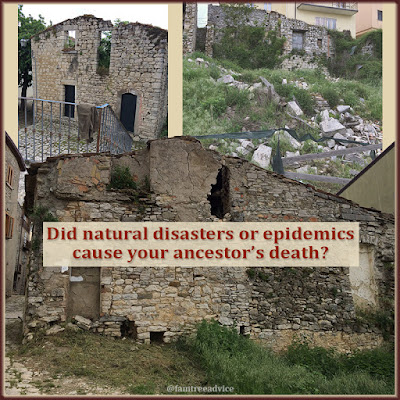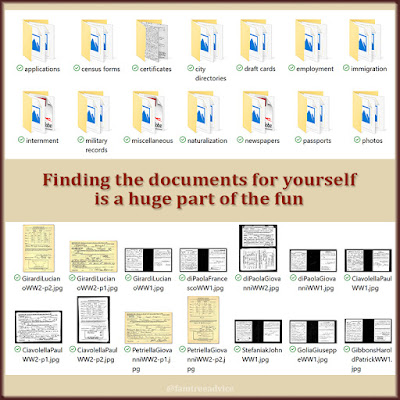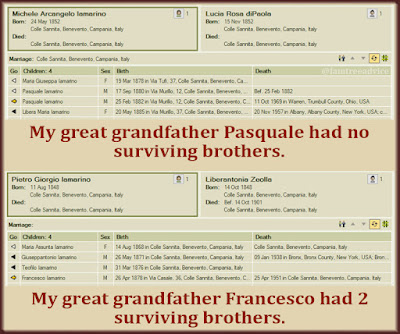The genealogy journey is fun. Being efficient makes it fun AND productive.
We all multi-task. Sometimes it's the only way to do the many things we need to do. But when it comes to genealogy, you'll gather more facts and documents if you focus.
Focus on the task at hand. Don't get distracted by what you see along the way. You can make a quick note to come back for that other shiny object later. But for now, do what you're there to do.
Here are 3 examples of how and why you need to keep your focus.
One Name Only
Last weekend I wanted to make progress on one of my 2019 genealogy goals. On my computer I have tons of vital records from my ancestral Italian hometowns.
My 2019 goal is to add every "Pozzuto" baby from one town to my family tree. Why Pozzuto? Because that last name has DNA matches to both my mom and my dad.
The birth records stretch from 1809–1915, and I was up to 1841.
Recently I've been renaming these thousands of files to include the name of the person(s) in the record. For example, I renamed the file
101577322_00004.jpg to
101577322_00004 Teofilo Mascia di Antonio and Salvatore Celestino Pugliese.jpg
101577322_00004 Teofilo Mascia di Antonio and Salvatore Celestino Pugliese.jpg
With renamed files, I can use Windows File Manager to search for any name. This is fantastic when I need to find out who or when someone married. (Note: I keep the number in the file name so I can easily find the link to the original image online.)
Then I thought, instead of renaming files and moving on, why not ID the Pozzuto babies as I rename the files? So that's what I did. As I rename a file and find a Pozzuto baby, I add them to my tree. In practically no time I renamed every birth record from 1841–1847, stopping for each Pozzuto baby.
I added 36 more Pozzuto babies to my family tree! For now, I ignored every file with my maiden name or my direct ancestors' names. They will be there when I need them. Focus is what's getting this goal done.
 |
| Leave that other information alone for now. Focus on your current goal for better results. |
Follow That Family
Earlier this year I finished another of my 2019 genealogy goals. I keep a spreadsheet of each document I add to my family tree. (I call it my document tracker.) The last column has a list of what I'm missing for a particular person. It lists the census years I need, their immigration record, marriage date, death, etc.
My goal was to search for each missing census listed as "need to find" on my document tracker.
I accomplished this goal by staying focused. I went through my document tracker's alphabetical list of people. I searched for, and usually found, the missing census forms. I noted them on the spreadsheet, and moved on to the next family.
Even though I still can't find some census sheets, I found most of them. And my goal was carefully worded for success. "Search for all missing census forms in Document tracker." That focus kept me on-task and got the job done.
Clean This One Spot
There are so many cleanup tasks you can do to your family tree. It's only natural that you'd develop a style after spending some time doing this crazy hobby. Then you want to go back and make your earlier work match your style.
I came up with a style of adding very detailed notes to the document images in my tree. If it's a census sheet, I start with:
- the line numbers to look at
- the proper title of the document
- a bunch of facts, including:
- supervisor's district number
- enumeration district number
- sheet number, etc.
- the image number, like "image 16 of 947"
- the URL
- the source citation (copied from the online collection where I found it)
By focusing on census sheets only, I was able to add all these facts to every census image in my tree. I gather every bit of that information each time I save a new image. But the cleanup task was for older documents I saved before I got so careful.
One of my 2020 genealogy goals will be to beef up and standardize the notes on every ship manifest image in my tree. I'm good at adding all the facts now, but I wasn't so good in the beginning. If I focus on only that task, I'll get it done faster.
 |
| Keep the focus on one task to improve your consistency and efficiency. |
Each time I sit down to work on my family tree, I choose a task. I might pick an item from my annual genealogy goals list. I might click away at a cleanup task. Or I might pick someone at random and search for their missing documents.
No matter which family tree task you choose to work on today, focus on that task! Ignore the other interesting things that pop up. (Or make a quick note and move on.) Stay focused, and at the end of the day you'll find you've gotten a lot further than you expected.


















